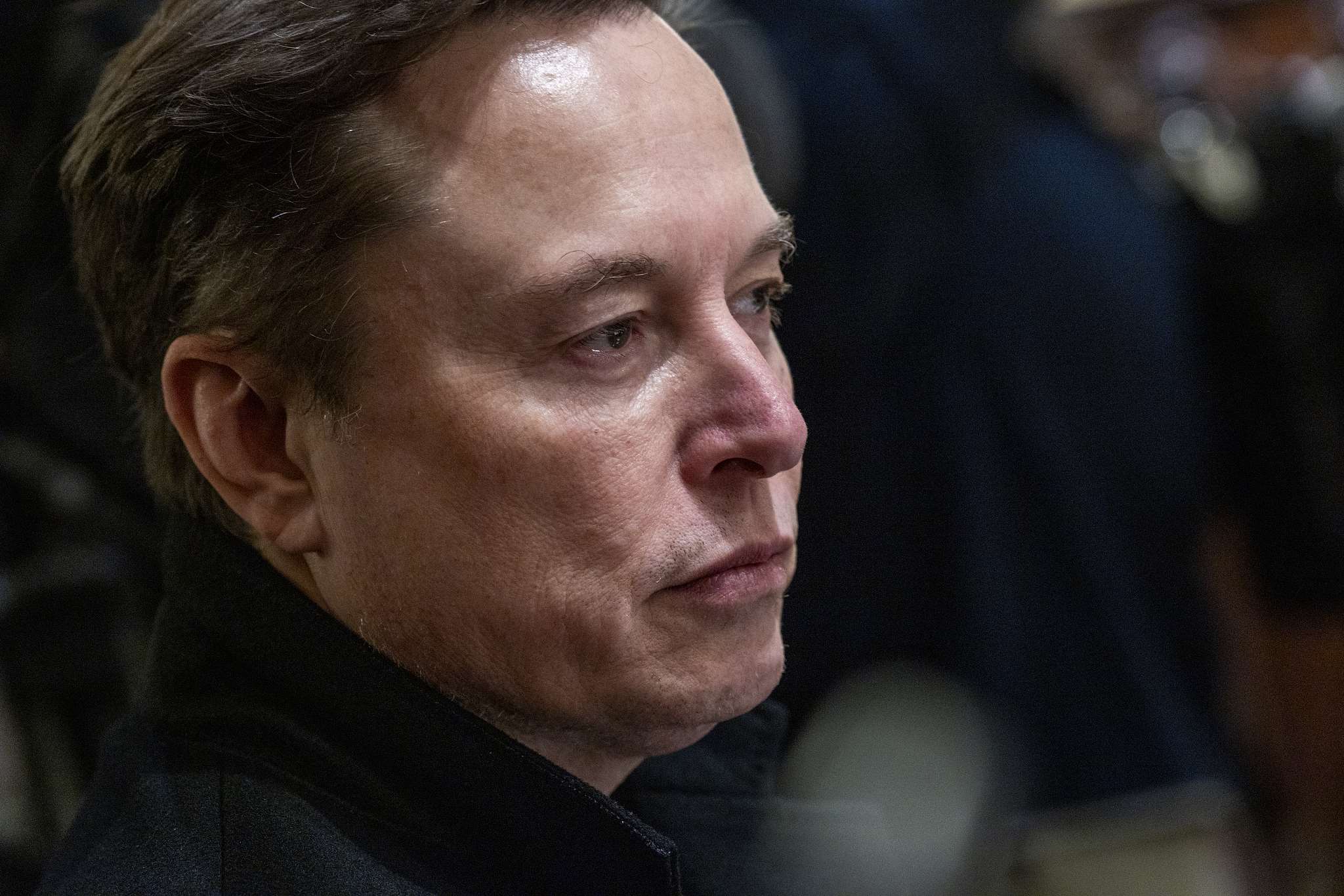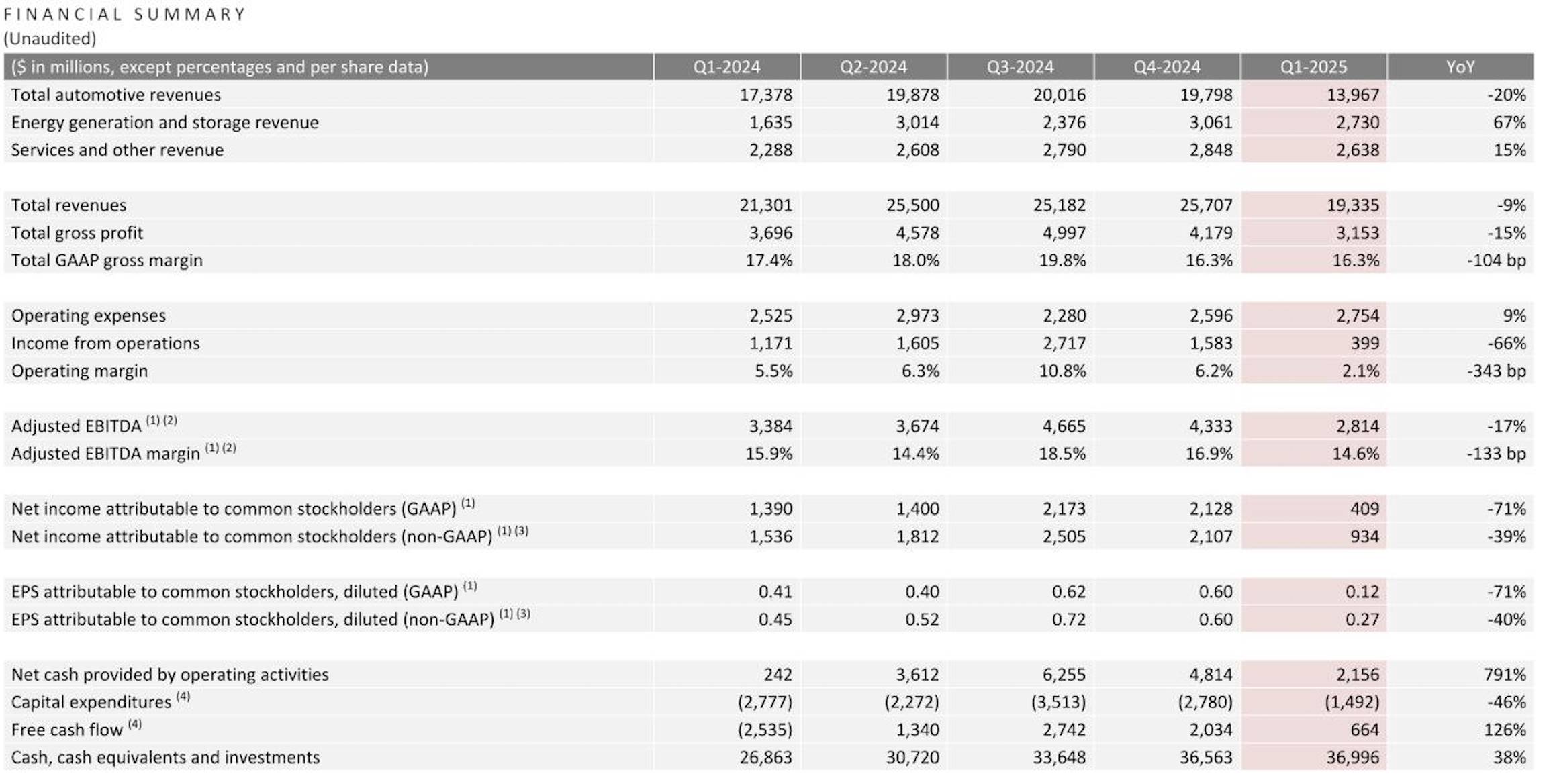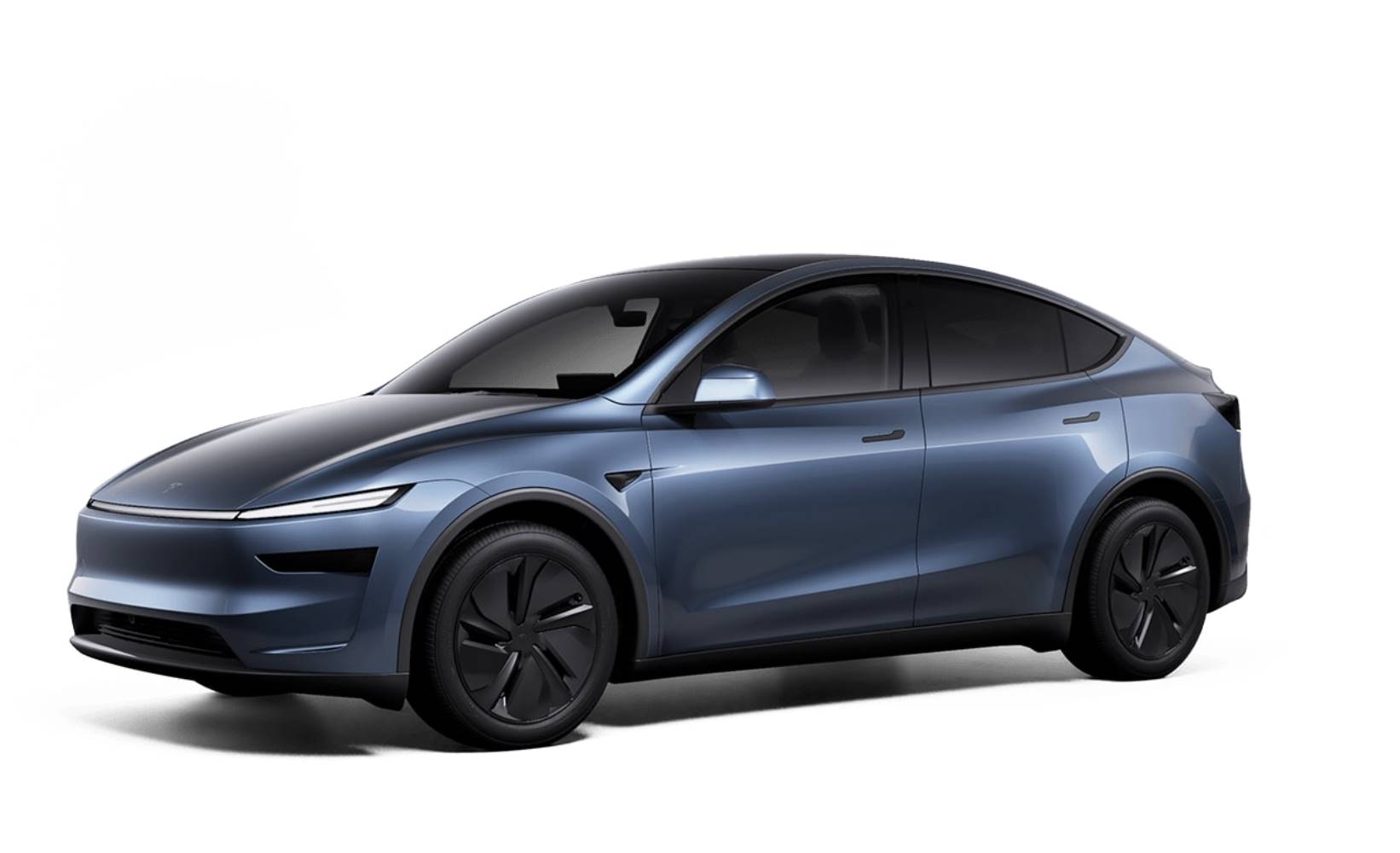Musk "Returns" to Entrepreneurial Status.
Author: Zhou Yongliang

Tesla released its first financial report after Trump's re-election.
On April 23, Tesla published its financial report for the first quarter of 2025. The report shows that Tesla's revenue for the first quarter of 2025 was $19.335 billion, a 9% decrease from $21.3 billion in the same period last year; in terms of profit, Tesla's net profit for the first quarter was only $409 million, a 71% decrease from $1.39 billion in the same period last year; adjusted net profit was $934 million, down 39% from $1.536 billion in the same period last year.
Despite the current performance challenges, Musk presented a "big pie." He stated during the earnings call that preparations for the production of a low-cost new model are proceeding as planned, with production expected to begin in the first half of 2025. Additionally, large-scale production of Robotaxi (self-driving taxis) is still expected to gradually begin in 2026.
At the same time, Musk also mentioned that starting in May, he would reduce his work with the Department of Government Efficiency (DOGE) to one or two days a week.
After the Tesla earnings call, the stock price rose after hours. As of the time of writing, Tesla's stock price had increased by 5.39% in after-hours trading. However, Tesla has already fallen more than 40% this year, evaporating over $530 billion, wiping out all gains since the U.S. election.
Net Profit Plummets 71%
In fact, Tesla's performance decline had long been foreshadowed. In early April, Tesla reported first-quarter deliveries of 336,700 vehicles, a 13% decrease from the same period last year. This is the lowest quarterly delivery figure Tesla has reported since the second quarter of 2022.
For Tesla, this decline is quite surprising. For a long time, Tesla maintained a growth rate of 20% to 100%, which supported its status as the world's most valuable car company.

Key financial data from Tesla's Q1 2025 report | Image source: Tesla financial report
From a regional market perspective, the situation shows some differences. Tesla performed relatively well in the Chinese market, delivering 137,000 vehicles in the first quarter, a year-on-year increase of 3.6%. However, despite achieving growth, the growth rate has significantly slowed compared to the past.
In contrast, the U.S. and European markets faced greater declines. Data shows that in the first quarter of this year, Tesla's deliveries in the U.S. were about 142,000 vehicles, a decrease of over 10% year-on-year; the European market nearly "collapsed," with sales in core markets like Germany, Denmark, and Sweden dropping by over 50%, and the Dutch market nearly halved, while sales in France fell by 41% year-on-year.
Although Musk has repeatedly stated that Tesla is an AI + robotics company, not just a car company, the current revenue structure still shows that the automotive business is Tesla's main source of income.
Therefore, the performance of the automotive business directly affects Tesla's overall financial situation. In the first quarter of this year, Tesla's total revenue was $19.335 billion, a 9% decrease compared to the same period last year. Among this, total revenue from the automotive business was $13.967 billion, a year-on-year decline of 20%.

Tesla Model 3 has been "defeated" by Xiaomi SU7 in the Chinese market | Image source: Tesla
In response, Tesla explained that the decline in automotive revenue was partly due to reduced deliveries caused by updates to the Model Y at its four major factories, as well as a change in model mix and sales incentives leading to a decrease in average selling price (ASP).
However, much of the blame has been placed on Musk's controversial experience as the head of the Department of Government Efficiency (DOGE) during the Trump administration, which may have negatively impacted Tesla's brand image and triggered protests and vandalism outside some Tesla showrooms; in the European market, Musk's public support for far-right parties in Germany and the UK has also contributed to a significant drop in sales.
Despite the challenges in the automotive business, Tesla's energy storage business has shown strong growth momentum, becoming its "second growth curve." Data shows that this business generated $2.73 billion in revenue, achieving a remarkable 67% growth compared to $1.635 billion in the same period last year. At the same time, Tesla's service business also maintained steady growth, with revenue reaching $2.638 billion, a 15% increase from $2.288 billion in the same period last year.
It is worth noting that the production capacity of the Shanghai energy storage super factory is rapidly increasing, having produced over 100 Megapack storage units.
In addition to revenue, gross margin is also an important consideration for observing Tesla. Data shows that Tesla's overall gross margin has dropped to 16.3%, down 1.1 percentage points from 17.4% in the same period of 2024, marking the lowest level in over a decade. Specifically, the gross margin for the automotive business (excluding regulatory credits) is only 12.5%. This also means that under the dual pressure of rising costs and intensified market competition, Tesla's profit margins are facing significant compression.
The simultaneous decline in both sales and gross margin directly affects Tesla's profitability. In the first quarter of 2025, net profit attributable to shareholders was $409 million, a substantial decrease of 71% compared to $1.39 billion in the same period last year. Adjusted net profit was $934 million, down 39% from $1.536 billion in the same period last year.
Will "Significantly" Reduce DOGE Work
Currently, the market's focus on Tesla, in addition to the already released first-quarter financial data, also includes Musk's role in the Trump administration and future focus, as well as Tesla's second-quarter performance guidance, progress on Robotaxi and affordable models, fulfillment of autonomous driving commitments, and tariff impacts.
In the recent earnings call, Musk admitted that Tesla has indeed encountered some "unexpected setbacks" this year. However, he emphasized that Tesla's operational status is stable and "not on the brink of death."
Regarding Musk's position in the Department of Government Efficiency (DOGE), market rumors suggest he may resign in May. This speculation has sparked widespread interest in whether he will return to Tesla full-time.

The Department of Government Efficiency led by Musk is facing "backlash" | Image source: Visual China
Musk acknowledged that his experience in the government department "has generated some backlash," but he emphasized that it is a "crucial job." He made it clear that he would not resign from his position in the U.S. government but plans to reduce his work commitment in that department to one or two days a week starting in May. This means Musk is trying to seek a new balance between government responsibilities and Tesla's operations.
In addition, the progress of affordable models and autonomous driving is also a focus of external attention.
Musk revealed in the meeting that preparations for the production of low-cost new models are proceeding as planned, with production expected to begin in the first half of 2025. Additionally, Tesla plans to start mass production of a self-driving taxi called "Cybercab" in 2026, with a pilot expected in Austin, Texas, in June 2025. Notably, this Cybercab will feature a fully autonomous design, without a steering wheel, accelerator, or brake pedal.
It is worth mentioning that it is reported that Model 3, Model Y, and Cybertruck can currently achieve autonomous driving from the production line to the logistics area at the Fremont factory and Texas Gigafactory.
However, consuming too much of the "big pie" can lead to indigestion. Tesla's commitments to affordable models and autonomous driving have persisted for years, but large-scale deliveries have yet to be realized. Furthermore, Tesla has not provided specific details about the upcoming affordable models, which has led to cautious expectations from the outside.
Automotive import tariffs are another topic of significant concern. Compared to other automakers, Tesla is relatively less affected, mainly because the cars sold in the U.S. are primarily produced in factories located in the U.S. In contrast, many major automakers import some vehicles from Mexico and other countries.
In response to this issue, Musk stated that he has provided advice to President Trump regarding tariff policies, but he also acknowledged that the final decision rests with the president. "I will continue to advocate for lowering tariffs rather than raising them, but that's all I can do."
In January 2025, Musk stated that this year would be the most important year in Tesla's history, preparing for the "epic revolution" in 2026. However, based on actual data, Tesla's revolutionary start has been disappointing. Whether Tesla will rise from the ashes or face a bubble burst remains to be seen. The answer may lie in Musk's "big pie." But for now, Tesla's most important task is to stabilize sales and wait for the maturation of its AI, robotics, and autonomous driving businesses.
免责声明:本文章仅代表作者个人观点,不代表本平台的立场和观点。本文章仅供信息分享,不构成对任何人的任何投资建议。用户与作者之间的任何争议,与本平台无关。如网页中刊载的文章或图片涉及侵权,请提供相关的权利证明和身份证明发送邮件到support@aicoin.com,本平台相关工作人员将会进行核查。




